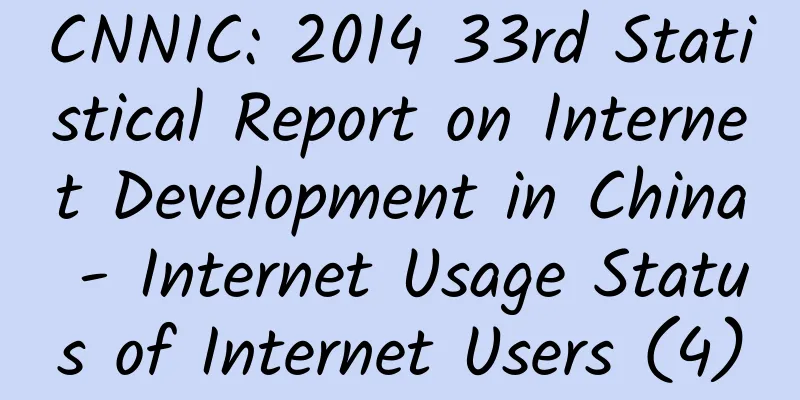CNNIC: 2014 33rd Statistical Report on Internet Development in China - Internet Usage Status of Internet Users (4)

|
CNNIC: 2014 33rd Statistical Report on Internet Development in China - Internet Citizens (1) CNNIC: 2014 33rd Statistical Report on Internet Development in China - Internet Usage Status of Internet Users (Part 2) CNNIC: The 33rd Statistical Report on Internet Development in China in 2014: Internet Basic Resources (3) CNNIC: The 33rd Statistical Report on Internet Development in China in 2014 - Internet Usage Status of Internet Users (4) CNNIC: 2014 33rd Statistical Report on Internet Development in China - Internet Behavior of Internet Users (5) 1. Development Status of Enterprise Internet Applications 1. Computer usage As of December 2013, the proportion of enterprises in China that used computers[Note 10] for office work was 93.1%. In terms of the size of employees, micro-enterprises with 7 or fewer employees have the lowest computer utilization rate, at only 83.5%, which is still a large gap compared with other scale enterprises. For enterprises with more than 100 employees, the computer utilization rate is close to 98%. Figure 72 Proportion of enterprises using computers (by enterprise size)Due to different economic development levels and industrial structures, there are certain differences in computer utilization rates among enterprises in different regions. The eastern region has the highest rate, followed by the western region, and the central region has the lowest rate, at only 84.8%. The use of computers is an important aspect of the basic application of enterprise informatization, and it has a promoting effect on eliminating the digital divide and information level gap between regions. Therefore, it is necessary to focus on promoting the use of computers in backward areas. Figure 73 Proportion of enterprises using computers (by region)2. Internet Usage As of December 2013, the proportion of enterprises in China using the Internet for office work[Note 11] was 83.2%. In terms of the size of employees, micro-enterprises with 7 or fewer employees still have the lowest Internet usage rate, 14.4 percentage points lower than the national average. However, the Internet usage rate of enterprises with more than 100 employees is over 90%. Figure 74 Proportion of enterprises using the Internet (by enterprise size)Similar to the difference in computer usage, the Internet usage rate of enterprises in the eastern region is the highest, reaching 87.7%, while that of enterprises in the central region is relatively low, only 70.5%. Although the western region has significantly caught up with the eastern region in computer usage, with a difference of less than 4 percentage points, there is still a certain gap in Internet usage between enterprises in the two regions. Figure 75 Proportion of enterprises using the Internet (by region)3. Broadband usage As of December 2013, the usage rate of fixed broadband in enterprises nationwide was 79.6%, making it the main way for enterprises to access the Internet. Figure 76 Enterprise Internet access methods2013 was a year of leapfrog development in China’s broadband construction. The Ministry of Industry and Information Technology officially launched the “Broadband China 2013 Special Action” and issued the “Opinions on Implementing the Broadband China 2013 Special Action”. Subsequently, the State Council issued the “Broadband China Strategy and Implementation Plan”, proposing that broadband networks will become a strategic public infrastructure for my country’s economic and social development in the new era, and proposed specific development goals and development timetables [Note 13]. Table 10 Development goals and timetable of “Broadband China”The continuous and in-depth development of broadband construction can not only drive the development of Internet applications of netizens, but also greatly promote the Internet applications of enterprises. On the one hand, broadband infrastructure construction has a promoting effect on the Internet in optimizing the industrial structure and improving the operational efficiency of enterprises. The "Notice on the "Broadband China" Strategy and Implementation Plan" specifically proposes to continuously expand and deepen the application of broadband in production and operation, accelerate the broadband networking of enterprises and network-based process reengineering and business innovation, use information technology to transform and upgrade traditional industries, realize networked, intelligent, intensive and green development, and promote industrial optimization and upgrading; on the other hand, broadband infrastructure construction drives the continuous development of high-tech industries, and specifically proposes to continuously innovate broadband application models, cultivate new markets and new formats, accelerate the development of modern service industries such as e-commerce, modern logistics, and network finance, and strengthen new generation information technology industries such as cloud computing, the Internet of Things, mobile Internet, and smart terminals. On December 4, 2013, the Ministry of Industry and Information Technology officially issued the fourth-generation mobile communication business licenses to China Unicom, China Telecom and China Mobile, marking that China's telecommunications industry has officially entered the 4G era. With faster communication speeds, lower rates and the ability to transmit large amounts of data, the 4G network will have broad application prospects in mobile office (such as mobile video conferencing, mobile OA systems), mobile e-commerce (such as mobile warehousing and logistics management, supply chain management, and mobile customer relationship management), etc., and will greatly promote the construction of mobile informatization in enterprises. II. Development of e-commerce and online marketing for SMEs 1. E-commerce usage As of December 2013, the proportion of enterprises nationwide that conduct online sales[Note 14] is 23.5%. Among some key industries, the proportions of manufacturing, wholesale and retail industries are relatively high, reaching 27.6% and 25.3% respectively. Affected by the characteristics of industry products, the proportion of online sales in real estate, residential services and other service industries is relatively low. Figure 77 Proportion of enterprises in key industries engaging in online salesAs of December 2013, the proportion of enterprises nationwide that conduct online procurement[Note 15] is 26.8%. Among some key industries, the proportion of online procurement in manufacturing, wholesale and retail industries is still relatively high, reaching 30.6% and 28.8% respectively; the utilization rate in real estate, residential services and other service industries is still relatively low. Overall, in the past year, the proportion of enterprises in various key industries that conduct online procurement has exceeded that of online sales. Figure 78 Proportion of enterprises in key industries that conduct online procurement(II) Use of Internet Marketing[Note 16] As of December 2013, the proportion of enterprises nationwide that used the Internet to carry out marketing and promotion activities[Note 17] was 20.9%. The survey results show that the highest rate of use of instant messaging tools for marketing promotion by the surveyed companies that have used the Internet to carry out marketing activities is 63.1%. For enterprises, instant messaging tools not only play a role in communication, but also play an important role in e-commerce and online marketing. With a huge user base, strong user stickiness and rich management tools, instant messaging tools have become an important tool for corporate marketing. In addition, the use rates of search engine marketing and e-commerce platform promotion are also high, reaching 56.0% and 47.6% respectively. From the perspective of consumer behavior patterns, search behavior directly points to purchase, and e-commerce platforms are the place where purchase behavior occurs. In addition, since the cost of marketing and promotion is limited, small and medium-sized enterprises are more inclined to choose methods with controllable investment and high cost performance. Figure 79 Utilization rate of various online marketing methods3. Characteristics and trends of Internet applications in small and medium-sized enterprises ◇The basic application of the Internet is steadily advancing, and micro-enterprises need to focus on strengthening The basic Internet application indicators such as computer utilization rate, Internet utilization rate and broadband utilization rate in Chinese enterprises have increased compared with last year, especially the broadband construction has achieved leapfrog development in 2013. Although the basic information application of computer and Internet in Chinese enterprises is generally popular, the gap between enterprises of different sizes still exists. The computer utilization rate and Internet utilization rate of micro-enterprises with 7 or less employees are lower than the national average level, and the gap is obvious. ◇ The utilization rate of e-commerce needs to be further improved, and some industries are developing relatively fast The utilization rate of e-commerce in my country's enterprises has remained stable in recent years, with the proportion of online purchases and online sales remaining around 25%. In the survey, it was found that although business owners' awareness of e-commerce has increased, the lack of effectiveness of online marketing and promotion, the difficulty in coordinating online sales channels with traditional channels, and the lack of e-commerce talents are still common concerns of business owners, which to a large extent restrict the development of corporate e-commerce. Looking further, the proportion of online purchases and online sales in the manufacturing, wholesale and retail, information transmission, computer services and software industries is much higher than that in other industries. The focus of e-commerce in the real estate, construction, transportation and service industries is on obtaining online information and promoting brands and products, and procurement and sales are still largely conducted offline. ◇The trend of network marketing methods becoming more concentrated Judging from the trend in the past two years, small and medium-sized enterprises have maintained the top three in terms of usage rate by using instant messaging tools, search engines, and e-commerce platforms for promotion. Except for the obvious increase in the usage rate of forums/BBS, other online marketing methods have all declined, including email marketing, website display ads, online video ads, online alliance ads, and group purchases. This shows that small and medium-sized enterprises are currently more focused on online marketing methods with a clear sales orientation, rather than display ads. Of course, this is also closely related to the characteristics of small and medium-sized enterprises, such as their relatively weak financial foundation and the fact that product sales demand is higher than brand display demand. Note 10: Computer refers to desktop or laptop computers and does not include devices with certain embedded computing capabilities such as mobile cellular phones, personal digital assistants (PDAs), or televisions. Note 11: Enterprises using the Internet for office work refers to the direct use of the Internet in various activities of enterprises. Although some enterprises use Internet media for advertising/promotion, they do not directly use the Internet for work and are not included. Any device with Internet access function (not just computers) can be used as a tool for using the Internet. This includes mobile phones, PDAs, game consoles and digital TVs. It can be used through fixed or mobile networks. Note 12: The Internet access utilization rate published in this survey refers to the proportion of enterprises that use various methods to access the Internet among the total number of surveyed enterprises. Note 13: //www.gov.cn/zwgk/2013-08/17/content_2468348.htm Note 14: Online sales investigated in this report refer to the act of receiving orders through the Internet, including through various means such as websites and emails. Note 15: Online purchasing investigated in this report refers to the act of sending orders through the Internet, including through various means such as websites and emails. Note 16: Refers to the use of the Internet to carry out marketing and promotion activities. Note 17: Includes advertisements or promotions placed by the enterprise itself or through agents/advertising companies, including paid promotions and free promotions. |
<<: Popular Science | Are you still lying on your stomach for a nap? Beware of myopia!
>>: eMarketer: Mobile email usage surpasses PC usage
Recommend
What to do about female genital infection
For every woman, having a baby is their dream. Of...
Can stretch marks be prevented?
Stretch marks can be prevented because they are c...
Postovulatory uterine rectal effusion
The female reproductive system is very complex an...
How to replenish blood and qi for women in summer
Many women need to replenish blood and nourish qi...
How to consume walnut oil? What is the shelf life of walnut oil?
Walnut oil is made by pressing, refining and puri...
Symptoms of Candida vaginitis and regular medication treatment
Vaginitis is currently divided into different typ...
Does formaldehyde affect menstruation?
When people enter a renovated house, they often s...
What happens during the fourth week of pregnancy?
The symptoms of morning sickness are not very obv...
What is the cause of vaginal discharge of clear gelatinous substance?
The phenomenon of vaginal discharge of gelatinous...
What to eat in the first week after giving birth
The normal delivery process of a pregnant woman i...
Can I open a durian that has not cracked? How can I store an unopened durian?
If the durian is not ripe, you can use temperatur...
What foods are bad for the ovaries?
Ovarian health care is very important. Modern fem...
What to do if you have abdominal pain during early pregnancy
Abdominal bloating and pain in the early stages o...
The director has a hard case
Women's private parts generally need regular ...
Can I have sex before IUD removal?
We all know that many women, in order to avoid pr...









